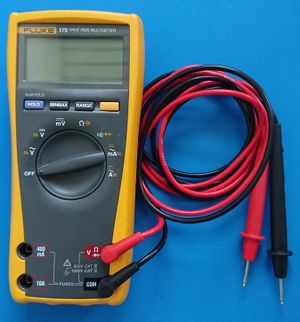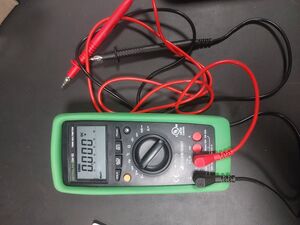Multimeters: Difference between revisions
NitramLegov (talk | contribs) m image |
NitramLegov (talk | contribs) m extrabox |
||
| (4 intermediate revisions by 3 users not shown) | |||
| Line 1: | Line 1: | ||
{{ | {{MachineInfoBox | ||
| | |machine name=Multimeters | ||
|image=Multimeter.jpg | |german=Multimeter|image=Multimeter.jpg | ||
|synonyms=multitesters;<br>DE: Vielfachmessgeräte | |synonyms=multitesters;<br>DE: Vielfachmessgeräte | ||
|material=circuits, [[Electronic Components|electronic components]] | |material=circuits, [[Electronic Components|electronic components]] | ||
| | |extrabox=yes | ||
}} | }} | ||
Multimeters are an essential tool for working with electronics. They are used – as the name suggests – to measure various values of a circuit like: | Multimeters are an essential tool for working with [[electronics]]. They are used – as the name suggests – to measure various values of a circuit like: | ||
* voltage – unit ''Volt'' (V) | * voltage – unit ''Volt'' (V) | ||
| Line 28: | Line 25: | ||
# done! | # done! | ||
<br clear="all" /> | |||
<!-- NOTE: The following block "imports" content from separate pages - please don't change the code! To edit the actual information, please go back and click "edit" next to the section headline you are interested in :-) --> | |||
{{#ask: | |||
[[MachineType::{{PAGENAME}}]] | |||
|order=ascending | |||
|format=embedded | |||
|embedonly=yes | |||
}} | |||
[[Category:Electronics]] | [[Category:Electronics]] | ||
[[Category:Marking & Measuring]] | [[Category:Marking & Measuring]] | ||
Latest revision as of 22:07, 10 October 2025
| MachineInfoBox Multimeters | |
|---|---|

| |
| Synonyms: | multitesters; DE: Vielfachmessgeräte |
| Material: | circuits, electronic components |
| Access Requirements: | Read the Wiki Page |
| Tutors: | |
Multimeters are an essential tool for working with electronics. They are used – as the name suggests – to measure various values of a circuit like:
- voltage – unit Volt (V)
- current – unit Ampere (A)
- resistance – unit Ohm (Ω)
- frequency – unit Hertz (Hz)
- capacitance - unit Farad (F)
- diode test – voltage needed to overcome the PN-gap
It is important to be aware of how to measure a certain value properly without interfering or even damaging the multimeter or the circuit. All multimeters have different inputs for measuring current and voltage. The voltage input is protected with a high input impedance (> 1 MΩ). When measuring current, the leads act as a dead short so be very careful when using this mode and always plug the leads back into the voltage input so another person can't accidentally short a circuit when using the multimeter.
How to Measure
- think about what value you want to measure (voltage, current, resistance, …)
- check if the leads are connected to the right input (black to COM and red to relevant input)
- turn the dial to the correct mode
- select the right range (e.g. mV, V) - newer multimeters may have an autorange feature so they select the right range on their own as long as the correct input socket is used
- hold the leads to the two points you want to measure
- done!
Fluke 175 RMS
| MachineInfoBox Fluke 175 RMS | |
|---|---|

| |
| Type: | Multimeters |
| Location: | Electronics Area |
| Access Requirements: | Read the Wiki Page |
| Status: | Working |
| Tutors: | |
Overview
The Fluke 175 is a reliable and accurate digital multimeter.
Key Features
- Measurement functions:
- AC/DC Voltage up to 1000 V
- AC/DC Current up to 10 A
- Resistance, Continuity, Diode Test, Capacitance, Frequency
- CAT III 1000 V / CAT IV 600 V Safety Rated
Usage Tips
Always start on the highest range to avoid damaging the meter. Use the correct input jacks and function dial position. Be cautious when working near high voltage.
Note:
Handle with care—this is precision equipment. Return it to its storage case after use.
== Fnirsi HRM-10 ==
| MachineInfoBox Fnirsi HRM‑10 | |
|---|---|

| |
| Type: | Multimeters |
| Location: | Electronics Area |
| Access Requirements: | Read the Wiki Page |
| Status: | Working |
| Tutors: | |
Overview
The Fnirsi HRM‑10 is a compact, handheld meter designed to measure both battery voltage (up to ±100 V DC) and internal resistance (0–200 Ω) with high precision
Key Features
- Voltage range: 0 to ±100 V DC (auto and 1 V/10 V/100 V ranges)
- Resistance range: 0 Ω to 200 Ω (auto, 20 mΩ to 200 Ω scales)
- True Kelvin 4‑wire connector with 1 kHz AC test signal for milliohm-level precision
- Pass/Fail mode with threshold settings and data storage/export
- USB‑C port for charging, and CSV data transfer
Use Cases
Battery health testing:
Internal resistance increases as batteries age. A high resistance reading—even if voltage looks okay—can mean the battery is no longer reliable under load.
User Notes
The Kelvin‑lead clamps must not touch each other when measuring, to ensure correct readings==GOSSEN METRAWATT METRALINE DM62==
| MachineInfoBox GOSSEN METRAWATT METRALINE DM62 | |
|---|---|

| |
| Type: | Multimeters |
| Location: | Electronics Area |
| Access Requirements: | Read the Wiki Page |
| Status: | Working |
| Tutors: | |
Overview
The METRALINE DM62 is a reliable and accurate digital multimeter.
Key Features
- ABS Automatic Blocking Sockets
- Measurement functions:
- AC/DC Voltage up to 1000 V
- AC/DC Current up to 10 A
- Resistance, Continuity, Diode Test, Capacitance, Frequency
- CAT III 600V / CAT IV 300 V Safety Rated
Usage Tips
Always start on the highest range to avoid damaging the meter. Use the correct input jacks and function dial position. Be cautious when working near high voltage.
Note:
Handle with care—this is precision equipment. Return it to its storage case after use.